Thursday, March 19th--Today was our tour to the Tokyo Imperial Palace. In order to be able to go on this tour, you have to fill out an application and receive an acceptance email. The tour is heavily supervised, and care is taken to make sure that the palace remains secure. It is the Imperial Palace, after all. We were looking forward to our tour, which started at 10 a.m.

The Tokyo Imperial Palace is where the Emperor and Empress of Japan live. It is on the site of the former Edo Castle, where the daimyo for the area resided. (Think of Hiroshima Castle, Edo Castle was the same thing.) The castle burned down in 1873, and all that remained were the foundations, stone walls and a couple of keeps. When Emperor Meiji moved the capital of Japan to Tokyo, he had the new Imperial Palace built on this spot using the remains of Edo Castle.
We saw a few swans floating in the moat.
We went into the first building and received audio guides since the tour is done in Japanese. We watched a short movie about the Imperial Palace and then followed the security guards out the door to begin our tour of the palace grounds.
Can you see a circle with a cross engraved on a stone in this picture? This picture is of the inner wall which provides protection to the Tokyo Imperial Palace. The wall was built as part of the Edo Castle. Various wealthy sponsors helped financially to construct the castle. To ensure that other people knew they made a contribution to the construction, they were allowed to engrave their family mark onto some of the stone blocks that made up the wall. There were markings all over the stone walls, and it was fun to search for them.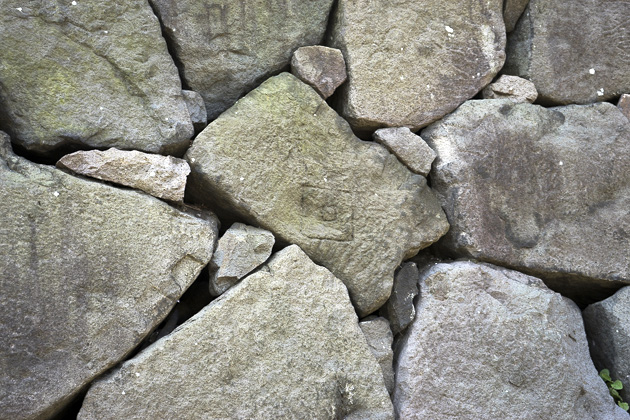
There are two markings here, can you find them both?
The first structure we came upon is called the Fujimi-yagura, or Mt. Fuji Viewing Tower. It was used as a keep, but at one time you could also see Mt. Fuji from it, hence the name. There were eleven keeps for Edo Castle, and this is one of the few remaining ones. It was used as the substiture main keep after the original main keep burned down in 1657 and was never rebuilt. It was also used by the shogun to watch fireworks over Tokyo Bay.
About 160 meters north of the Fujimi-yagura is the site of Matsu-no-Oroka, which was the scene of the attack of Daimyo Asano Naganori on a court official named Kira Yoshinaka. This attack led to the famous 47 ronin incident.This is the Imperial Household Agency building, which acts as a government organization placed under the Prime Minister. It takes charge of the state matters concerning the Imperial House. It is mainly the administration building. It also assists His Majesty in receiving foreign ambassadors and ministers and performing ceremonial functions.
This building served as the temporary Imperial Palace when the original was bombed during the air raids that hit Tokyo during World War II.
The next stop on our tour was the Imperial Palace itself! When the capital of Japan was moved from Kyoto to Tokyo in 1868, construction on this new Imperial Palace began. It was finished in 1888. However, it was destroyed in WWII. This palace was rebuilt in the same style as the one that was destroyed and was finished in 1968. It is a humongous building! The steel-framed, concrete enforced Imperial Palace stands two-stories high, and has one underground level. The roof is gabled and flanked with columns.
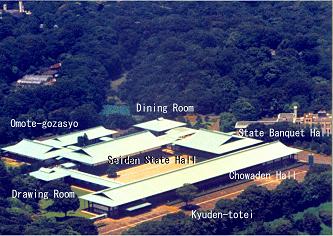
The palace consists of seven buildings which are connected by hallways.
This is not where the Emperor and Empress live, they have their own separate and private residence. Instead, this building is used for both receiving state guests and holding official state ceremonies and functions.
When dignitaries arrive at the palace, they will enter though this door. Notice the rain chains on either side....they are so big around. I would love to see them when it is raining, I bet they are beautiful.
This large courtyard is where thousands of people will gather twice a year when the Imperial Palace opens to the public. (You don't need to apply and receive permission to enter the grounds.) Those days are for the New Year (Jan. 2) and for the Emperor's birthday (Dec. 23). On those occasions, the Emperor and his family can be seen through these bullet proof windows. They will greet the thongs of people and wave.
This is what this courtyard looks like on the two days when the Emperor and his family make public appearances.
After passing the Imperial Palace, we went through a gate and walked onto a famous landmark of Japan......

.....the Nijubashi Bridge! This bridge regularly appears on guidebooks and postcards and is arguably the most famous bridge in Japan – even a symbol of Japan itself. It is only used for important state occasions or delegations from abroad who are coming to the Imperial Palace. This is the view of the bridge from the street.

The bridge was built in 1614 by the shōgun, Tokugawa Hidetada. It is kind of fun to see pictures of it a really long time ago! Fushimi-yagura can be seen in the background.
Here are most of the kids on Nijubashi. The lamp posts on the bridge were simply gorgeous. While we were walking on the bridge, the security guards kept asking our tour group to stay directly in the middle of the bridge, they didn't want any of us anywhere near the edge. They told us that it was unsafe.
Fushimi-yagura is a tower that used to be at Fushimi Castle in Kyoto. When the castle was destroyed in the 17th century, the shogun ordered this tower to be taken apart piece by piece and moved to this location. It was then put back together. It is said to be the most beautiful building within the palace grounds.
As we were standing on Nijubashi Bridge, we could see another picturesque bridge as we looked toward Tokyo. This bridge is called the Meganebashi Bridge. When dignitaries and other heads of state come to the Imperial Palace, they will drive over this bridge, pass the stone wall shown on the right of this picture, and then cross over the Nijubashi Bridge....
....and go through this gate. Beyond this gate is the courtyard and the Imperial Palace. This picture is from the internet because when we were here on our tour, there were too many people on the bridge for me to get a decent enough picture to show the gate and the bridge, along with the very pretty lamp posts.
These bridges and gates are closed to the public except for the two days in the year when the palace is open to the public. On those days, the public will enter the palace grounds by way of these bridges and gate.
After spending a little time on the Nijubashi Bridge, we went back through the gate and walked over the large courtyard again.
We came around to the other side of the palace and saw this entrance door. There were some men working on the roof as we passed. Beyond this entrance is a tea room and a banquet hall. I bet it is beautiful inside!
We walked along this small paved street for a little way, enjoying the landscape of trees that were on either side. Raymond and Audra are in the center of this picture.
Beyond these trees, where the private Imperial residence is, lie the Emperor's rice fields.
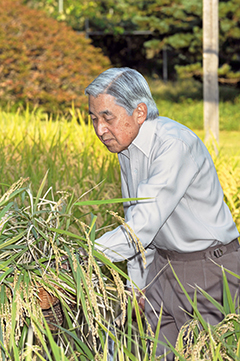

Every year, following the example of his father who initiated the practice in 1927, the Emperor himself plants and harvests rice, the traditional main crop in Japan. He does this at the paddy-field in the Palace Grounds.
The Empress also has an interesting pastime; she raises silkworms at the Palace sericulture center, following the precedent set in 1871 by Empress Dowager Shoken. Some of the silk produced is used to repair old textile material of historical value for Japan.
We did not get to see the paddy-field or the sericulture center, but we were told about them and it is fun to hear that the Emperor and Empress are not afraid to get their hands dirty. It is also nice to know that they want to honor their culture and family heritage by continuing these traditions.
As we continued on, we saw the hasuikebori, or the lotus-filled moat. This provides added protection for the Imperial residence where the Emperor lives, but is also supposed to be amazingly beautiful.
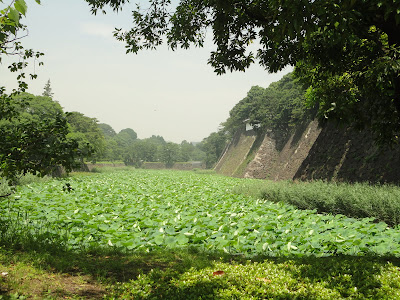
Unfortunately, it wasn't that impressive when we were there because of the time of year. So, here is a picture of what it looks like in the summertime. Much prettier!
As we circled around and headed back to the first building that we went to, we again passed the stone walls that had the family markings on them. We kept stopping to look for markings, but the security guards did not like that and hurried us along.
We turned in our audio translators and made our way back out the way we came in.
The family in front of one of the gates left from when this place was Edo Castle. This was a cool gate, the walls were really thick here. This is called the Soto Sakurada Gate.
Then, we passed back over the moat and through this last gate, the Kikyo-mon, and our tour of the Imperial Palace was over. In Edo Era, this gate was used for important feudal lords of the Tokugawa shogun.
The Imperial Palace tour isn't the most exciting thing we have done in our time here, but it was worthwhile nonetheless! There is a lot of history here, and the buildings and bridges were beautiful. It was fun to see the family markings on the stone walls and learn more about the Imperial family. I think our favorite part was the Nijubashi Bridge. It was neat to be able to stand on such an iconic landmark for Japan! The Imperial Palace is the heart and soul of Tokyo, just at the Emperor is the heart and soul of Japan. I'm glad that we were able to go on our tour here!


















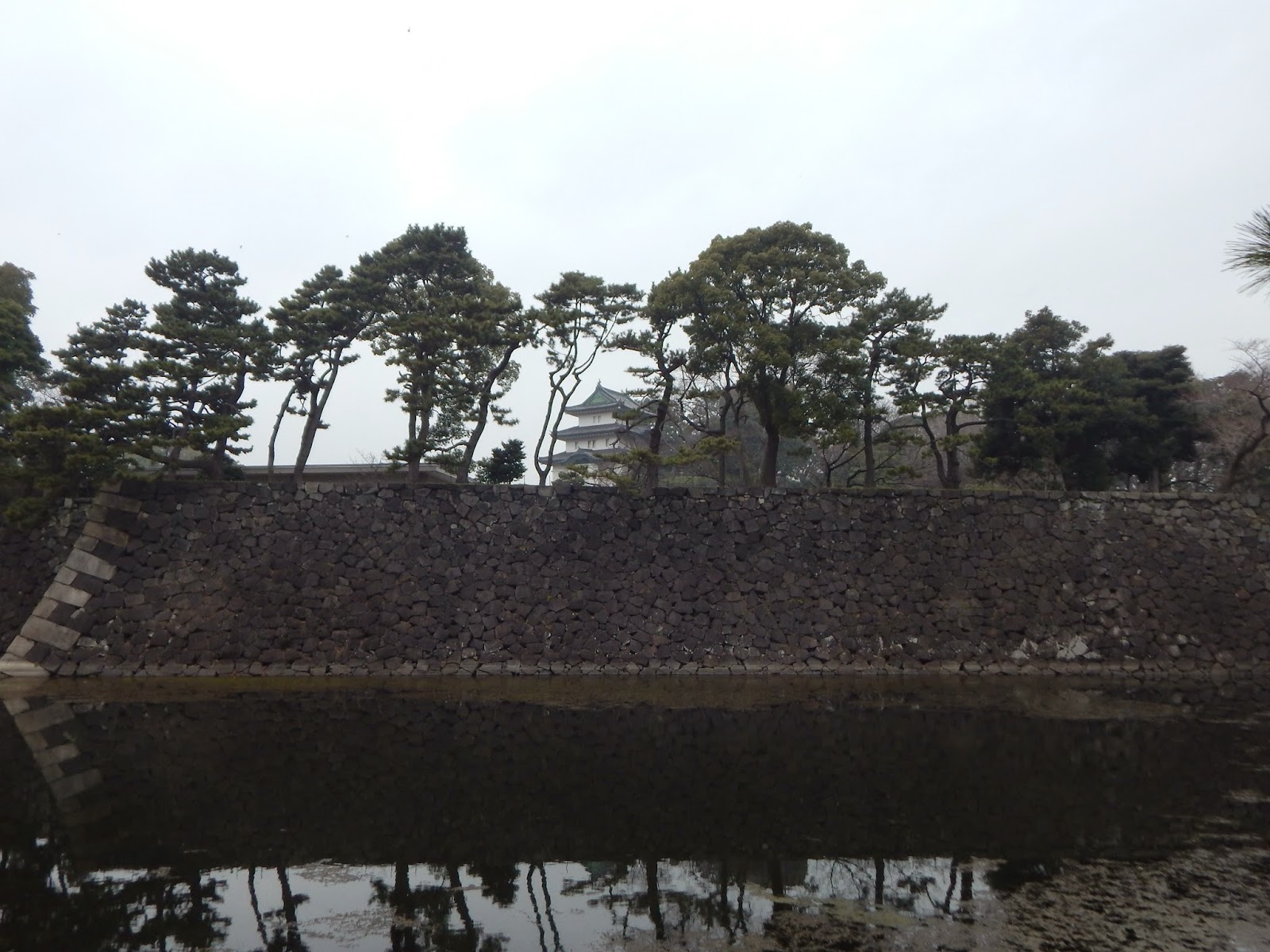
No comments:
Post a Comment